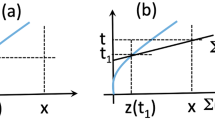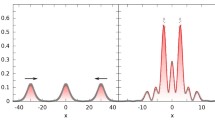Abstract
In this work we develop a time-symmetric soliton theory for quantum particles inspired from works by de Broglie and Bohm. We consider explicitly a non-linear Klein–Gordon theory leading to monopolar oscillating solitons. We show that the theory is able to reproduce the main results of the pilot-wave interpretation for non interacting particles in a external electromagnetic field. In this regime, using the time symmetry of the theory, we are also able to explain quantum entanglement between several solitons and we reproduce the famous pilot-wave nonlocality associated with the de Broglie-Bohm theory.








Similar content being viewed by others
Data Availability
No data associated in the manuscript.
Notes
We use the Minkowski metric \(\eta _{\mu \nu }\) with signature \(+,-,-,-\) and the convention \(\hbar =1\), \(c=1\).
In [22] we obtained the expression for \({\mathcal {M}}_{u}(x)\) (Eq. 66) without expliciting the first order correction \(O(\xi )\). The details of the calculations show that we have \({\mathcal {M}}_{u}(x)\simeq {\mathcal {M}}_{\Psi} (z(\tau ))+{\varvec{\xi }}\cdot {\varvec{\nabla }}{\mathcal {M}}_{\Psi} (z(\tau ))+O(\xi ^{2})\). A careful analysis shows that we have \(\partial _{\mu} {\mathcal {M}}_{u}(z(\tau ))=\partial _{\mu} {\mathcal {M}}_{\Psi} (z(\tau ))\).
We have the fluid conservation: \(v_{u}\partial \ln {(f^{2}{\mathcal {M}}_{u}\delta ^{3}\sigma _{0})}:=\frac{d}{d\tau }\ln {(f^{2}{\mathcal {M}}_{u}\delta ^{3}\sigma _{0})}=0\).
Ehrenfest theorem has been also applied by Bialynicki-Birula and Mycielski [5] in the context of classical Gausson dynamics driven by external electromagnetic forces. The theorem has also been used by Durt and coworkers [10, 33] in the particular context of the nonrelativistic Schrödinger–Newton equations. Our own independent results are based on the relativistic NLKG an is valid for a large range of equations.
This invariance allows us to circumvent the conclusions of the Hobart–Derrick theorem [17, 31, 34] which usually precludes the existence of static and stable solitons in 3D space. In “Appendix 2” we give an elementary proof of this result.
We stress that de Broglie rejected the non singular wave \(u(t,r)=e^{-i\omega _{0} t}\frac{\sin {(\omega _{0} r)}}{r}\) solution of the homogeneous wave equation. This alternative solution was later rediscovered by many authors including Mackinnon [36] and Barut [3]. At the experimental level such non dispersive de Broglie waves have been recently created [32] using optical methods inspired from diffraction-free beams works [23]. This is also related to the work of Fink concerning time reversal mirrors in acoustics and optics [2, 29] that plays with causality. This could perhaps play a role in order to develop a physical wave analog of our time symmetric soliton.
We have \(G^{(0)}_{sym,\omega }(R)=\frac{1}{2}[G^{(0)}_{ret,\omega }(R)+G^{(0)}_{adv,\omega }(R)]\) and \(G^{(0)}_{ret/adv,\omega }(R)=\frac{e^{\pm i\omega R}}{4\pi R}\) are the retarded and advanced Green functions respectively.
We have also \(K^{(0)}_{sym}(x,x')=\int _{-\infty }^{+\infty }G^{(0)}_{sym,\omega }(R)e^{-i\omega (t-t')}\frac{d\omega }{2\pi }\) with \(G^{(0)}_{sym,\omega }(R)\) given by Eq. 34.
More precisely we have \(\sigma _{\mp} =r\left( 1+\frac{\xi \ddot{z}}{2} \mp \frac{r\xi z^{(3)}}{6}-\frac{r^{2}(\ddot{z})^{2}}{24}+\frac{3(\xi \ddot{z})^{2}}{8}\right) +O(r^{4})\) with \(z^{(3)}:=\frac{d^{3} z(\tau )}{d\tau ^{3}}\).
A proof is obtained by using the Fourier transform \(K(x,x')=\int \frac{d^{4}k}{(2\pi )^{4}}e^{ik(x-x')}G_{k}\). Equation 49 reads thus \(G_{k}=G_{k}^{(0)}+G_{k}^{(0)}(e^{2}A^{2}-2eAk)G_{k}\), i.e., \(G_{k}=\frac{G_{k}^{(0)}}{1-(e^{2}A^{2}-2eAk)G_{k}^{(0)}}\). Using \(G_{k}^{(0)}=-1/k^{2}\) we deduce \(G_{k}=-1/(k-eA)^{2}\) and after using the inverse Fourier transform we obtain \(K_{sym}(x,x')=K^{(0)}_{sym}(x,x')e^{-ieA(z)(x-x')}\).
To prove this rather general statement a qualitative argument could go like this: Considering the LKG equation \(D^{2}\Psi =-\omega _{0}^{2}\Psi \) in a electrostatic potential \(V({\textbf{x}})\) the first Born order scattering amplitude for an incident plane wave \(\Psi _{0}({\textbf{x}})=e^{ik\textbf{n}_{0}\cdot {\textbf{x}}}\) (with \(k^{2}=\omega ^{2}-\omega _{0}^{2}\)) reads \(\Psi _{s}\simeq -2\omega \int d^{3}{\textbf{x}}''G_\omega ^{(0)}({\textbf{x}},{\textbf{x}}'')eV({\textbf{x}}'')\Psi _{0}({\textbf{x}}'')\simeq -2\omega \frac{e^{ikr}}{4\pi r} e\hat{V}_{\textbf{q}}\) where we neglected the quadratic term \(e^{2}V^{2}\), \(G_\omega ^{(0)}({\textbf{x}},{\textbf{x}}'')=\frac{e^{ikR|{\textbf{x}}-{\textbf{x}}''|}}{4\pi |{\textbf{x}}-{\textbf{x}}''|}\) [computed here for a retarded wave], and where \(\hat{V}_{\textbf{q}}\) is the Fourier transform of the potential at the wave wavevector \(\textbf{q}=k(\textbf{n}_{s}-\textbf{n}_{0})\). In a Coulomb field for example we have \(\Psi _{s}\simeq -\frac{2\omega \alpha }{\textbf{q}^{2}}\frac{e^{ikr}}{ r}\). The same calculation done for a plane wave solution of the linearized equation for u \(D^{2}u=0\) leads to the same expression with \(\omega ^{2}\) replacing \(k^{2}\). Therefore the scattered field \(u_{s}\) is smaller than \(\Psi _{s}\) by a coefficient \(\frac{u_{s}}{\psi _{s}}\simeq k^{2}/\omega ^{2}=v^{2}\) where v is the particle velocity. In general \(v^{2}\ll 1\) and \(u_{s}\) is negligible.
We have \(D_{i}=\partial _{i}+eA(x_{i})\), \(\partial _{i}:=\frac{\partial }{\partial x_{i}}\) and the polar form \(\Psi _{N}(x_{1},\ldots ,x_{i},\ldots ,x_{N})=a_{N}(x_{1},\ldots ,x_{i},\ldots ,x_{N})e^{iS_{N}(x_{1},\ldots ,x_{i},\ldots ,x_{N})}\).
This is also true in the recent important experimental/theoretical work done with hydrodynamical analogs by Bush, Vervoort and coworkers [38, 40, 50]. In these experiments there is a form of superdeterminism driven by stationnary Faraday waves moving along a liquid surface. Yet, the development was for the moment limited to time-independent configurations like in the first Aspect’s experiments. Time varying settings would require a stronger conspiracy that can be generated by a time symmetric causality. The problem is thus to generate the right amount of conspiracy in order to reproduce quantum predictions and not look too magical or too contrived. This is exactly the solution offered in the present work with non-linear waves involving time symmetry.
The error is small in the integration since \(U(f^{2})-f^{2}N(f^{2})\sim 1/r^{6}\) at large distances.
This description made in the regime \(\omega _{0}T\gg 1\) is of course an approximation that neglects the transient effects associated with the discontinuities at A and B contributing to the energy balance.
Of course the problem is absent if we limit the present model to neutral solitons with \(e=0\).
Note that in order to have \(I_{p}< \infty \) we must have \(m>\frac{3}{2(p+1)}\) so that globally \(m> max\left[ \frac{1}{2},\frac{3}{2(p+1)}\right] \) [45].
References
Bacciagaluppi, G., Valentini, A.: Quantum Theory at the Crossroads: Reconsidering the 1927 Solvay Conference. Cambridge University Press, Cambridge (2009)
Bacot, V., Labousse, M., Eddi, A., Fink, M., Fort, E.: Time reversal and holography with spacetime transformations. Nat. Phys. 12, 972–977 (2016)
Barut, A.O.: \(E=\hbar \omega \). Phys. Lett. A 143, 349–352 (1990)
Bell, J.S.: On the Einstein Podolsky Rosen Paradox. Physica 1, 195–200 (1964)
Bialynicki-Birula, I., Mycielski, J.: Nonlinear wave mechanics. Ann. Phys. 100, 62–93 (1976)
Bohm, D.: A suggested interpretation of the quantum theory in terms of “Hidden’’ variables. Phys. Rev. 85, 166–179 (1952)
Bohm, D.J., Hiley, B.J.: Nonlocality in quantum theory understood in terms of Einstein’s nonlinear field approach. Found. Phys. 11, 529–546 (1981)
Bohm, D., Hiley, B.J.: The Undivided Universe. Routledge, London (1993)
Chandrasekhar, S.: Chapter 4. In: An Introduction to the Study of Stellar Structures. University of Chicago Press, Chicago (1939)
Collin, S., Durt, T., Willox, R.: L. de Broglie’s double solution program: 90 years later. Ann. Fond. de Broglie 42, 19–70 (2017)
Costa de Beauregard, O.: Une réponse à l’argument dirigé par Einstein, Podolsky et Rosen contre l’interprétation bohrienne des phénomènes quantiques. C. R. Acad. Sci. (Paris) 236, 1632 (1953)
Cramer, J.G.: The transactional interpretation of quantum mechanics. Rev. Mod. Phys. 58, 647 (1986)
De Broglie, L.: Sur la fréquence propre de l’électron. C. R. Acad. Sci. (Paris) 180, 498–500 (1925)
De Broglie, L.: Ondes et mouvements. Gauthier-Villars, Paris (1926)
De Broglie, L.: Radium. J. Phys. 8, 225–241 (1927). (Translated in: de Broglie, L., and Brillouin, L.: Selected papers on wave mechanics. Blackie and Son, Glasgow (1928))
De Broglie, L.: Une tentative d’interprétation causale et non linéaire de la mécanique ondulatoire: la théorie de la double solution. Gauthier-Villars, Paris (1956). (Translated in: de Broglie, L.: Nonlinear wave mechanics: A causal interpretation. Elsevier, Amsterdam (1960))
Derrick, G.H.: Comments on nonlinear wave equations as models for elementary particles. J. Math. Phys. 5, 1252–1254 (1964)
Dirac, P.A.M.: Classical theory of radiating electrons. Proc. R. Soc. Lond. A 167, 148–169 (1938)
Drezet, A.: Quantum nonlocality of single photon state? Found. Phys. Lett. 19, 459–470 (2006)
Drezet, A.: Lorentz-invariant, retrocausal, and deterministic hidden variables. Found. Phys. 49, 1166–1199 (2019)
Drezet, A.: The guidance theorem of de Broglie. Ann. Fond. de Broglie 46, 65–85 (2021)
Drezet, A.: Quantum solitodynamics: non-linear wave mechanics and pilot-wave theory. Found. Phys. 53, 31 (2023)
Durnin, J., Miceli, J.J., Eberly, J.H.: Diffraction-free beams. Phys. Rev. Lett. 58, 1499–1501 (1987)
Einstein, A., Podolsky, B., Rosen, N.: Can quantum-mechanical description of physical reality be considered complete? Phys. Rev. 47, 777–780 (1935)
Fargue, D.: Permanence of the corpuscular appearance and non linearity of the wave equation. In: Diner, S., et al. (eds.) The Wave-Particle Dualism, pp. 149–172. D. Reidel Publishing, Dordrecht (1984)
Fargue, D.: Louis de Broglie’s “double solution’’, a promising but unfinished theory. Ann. Fond. de Broglie 42, 9–18 (2017)
Fer, F.: Les solutions singulières des équations d’onde et la théorie de la double solution. Doctorate Thesis, Bureau de documentation minière, Paris (1957)
Fer, F.: Guidage des particules, onde singulières. In: L. de Broglie, sa conception du monde physique, p. 279. Paris (1973)
Fink, M.: Time reversed acoustics. Phys. Today 50, 34–40 (1997)
Fokker, A.D.: Ein invarianter variationssatz für die bewegung mehrerer elektrischer massenteilchen. Z. Phys. 58, 386–393 (1929)
Goldstone, J., Jackiw, R.: Quantization of nonlinear waves. Phys. Rev. D 11, 1486–1498 (1975)
Hall, L.A., Abouraddy, A.F.: Observation of optical de Broglie–Mackinnon wave packets. Nat, Phys. 19, 435–444 (2023)
Hatifi, M., Lopez-Fortin, C., Durt, T.: De Broglie’s double solutions: limitations of the self-gravity approach. Ann. Fond. de Broglie 43, 63–90 (2018)
Hobart, R.H.: On the instability of a class of unitary field models. Proc. Phys. Soc. 82, 201–203 (1963)
Hoyle, F., Narlikar, J.V.: Cosmology and action-at-a-distance electrodynamics. Rev. Mod. Phys. 67, 113–155 (1995)
Mackinnon, L.: A nondispersive de Broglie wave packet. Found. Phys. 8, 157–176 (1978)
Mie, G.: Grundlagen einer Theorie der Materie. Ann. Phys. (Berl.) 99, 1–40 (1912)
Nikolaev, V., Vervoort, L.: Aspects of superdeterminism made intuitive. Found. Phys. 53, 17 (2023)
Page, L.: A generalization of electrodynamics with applications to the structure of the electron and to non-radiating orbits. Phys. Rev. 18, 292 (1921)
Papatryfonos, K., Vervoort, L., Nachbin, A., Labousse, M., Bush, J.W.M.: Bell test in a classical pilot-wave system (2022). arXiv:2208.08940
Petiau, G.: Sur la représentation des corpuscules en interaction avec des champs extérieurs par des fonctions d’ondes à singularités localisées. C. R. Acad. Sci. (Paris) 239, 344–346 (1954)
Petiau, G.: Quelques cas de représentation des corpuscules en intéraction avec des champs extérieurs dans la nouvelle forme de la mécanique ondulatoire (Théorie de la double solution). Sémin. L. de Broglie Théor. Phys. (Paris) 24, exposé 18 (1954–1955)
Petiau, G.: Sur la détermination de fonctions d’ondes à singularités localisées mobiles décrivant des trajectoires circulaires dans le cas d’un potentiel extérieur central. C. R. Acad. Sci. (Paris) 239, 2491–2493 (1955)
Rosen, G.: Particlelike solutions to nonlinear scalar wave theories. J. Math. Phys. 6, 1269–1272 (1965)
Rosen, G.: Existence of particle-like solution to nonlinear field theories. J. Math. Phys. 7, 2066–2070 (1966)
Rybakov, Yu.P., Saha, R.: Soliton model of atom. Found. Phys. 25, 1723–1731 (1995)
Schwinger, J.: Electromagnetic mass revisited. Found. Phys. 13, 373–383 (1983)
’t Hooft, G.: Free will in the theory of everything (2017). arXiv:1709.02874v2
Tetrode, H.: Über den Wirkungszusammenhang der Welt. Eine Erweiterung der klassischen Dynamik. Z. Phys. 10, 317–328 (1922)
Vervoort, L.: Are hidden-variable theories for pilot-wave systems possible? Found. Phys. 48, 803–826 (2018)
Wharton, K.B., Argaman, N.: Colloquium—Bell’s theorem and locally mediated reformulations of quantum mechanics. Rev. Mod. Phys. 92, 021002 (2020)
Wheeler, J.A., Feynman, R.P.: Interaction with the absorber as the mechanism of radiation. Rev. Mod. Phys. 17, 157–181 (1945)
Author information
Authors and Affiliations
Corresponding author
Ethics declarations
Conflict of interest
Author declares no competing interest for this work.
Additional information
Publisher's Note
Springer Nature remains neutral with regard to jurisdictional claims in published maps and institutional affiliations.
Rights and permissions
Springer Nature or its licensor (e.g. a society or other partner) holds exclusive rights to this article under a publishing agreement with the author(s) or other rightsholder(s); author self-archiving of the accepted manuscript version of this article is solely governed by the terms of such publishing agreement and applicable law.
About this article
Cite this article
Drezet, A. A Time-Symmetric Soliton Dynamics à la de Broglie. Found Phys 53, 72 (2023). https://doi.org/10.1007/s10701-023-00711-z
Received:
Accepted:
Published:
DOI: https://doi.org/10.1007/s10701-023-00711-z




